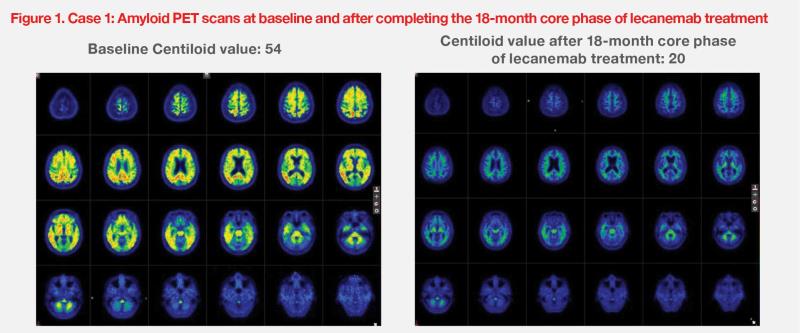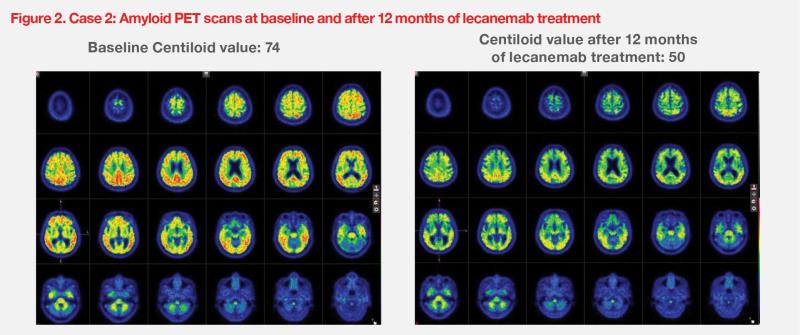Clinically meaningful benefits and biological clearance of amyloid load after initiating and continuing lecanemab treatment in two patients with Alzheimer’s disease













Case 1: Pathological clearance and clinical stabilization (patient’s and caregiver’s perspectives)
The patient is a 72-year-old retired university lecturer, first featured in MIMS Doctor in September 2024, who presented with subtle cognitive decline. Although he had no family history of dementia and self-reported minimal symptoms, his family noted increasing forgetfulness, stress-induced confusion, and difficulty managing daily tasks. Neurocognitive assessment revealed a Montreal Cognitive Assessment (MoCA) score of 25/30, consistent with mild impairment, while neuroimaging confirmed cerebral atrophy with an Alzheimer’s Disease (AD)–Resemblance Atrophy Index (AD-RAI) of 98 percent. Amyloid PET scan demonstrated a positive amyloid burden (Centiloid value, 54), and APOE genotyping identified ε3/ε4 heterozygosity.
Following limited benefit from oral AD medications and supplements, the patient commenced intravenous lecanemab in late 2023. Even though no premedication (usually prescribed to address infusion-related reactions [IRRs] and typically includes antihistamines, acetaminophen, NSAIDs, or corticosteroids prior to infusions) was given after the initial four doses of lecanemab, no adverse infusion reactions were reported throughout the treatment period.1,2 Screening MRI showed two new microbleeds without any siderosis or other abnormality after commencement of lecanemab treatment. Upon completion of the 18-month core treatment phase, amyloid PET scan showed a dramatic reduction in amyloid burden. The Centiloid value was reduced from 54 to 20. (Figure 1) After that, the patient transitioned to maintenance therapy.

Clinically, there was a slight cognitive decline, with MoCA score decreasing modestly from 21 to 19; the decline primarily affects naming and orientation. Functionally, he continued to engage in social and religious activities, with family members reporting improved verbal interaction and less frequent episodes of confusion. Although he is less interested in engaging in social activities and is becoming less physically active, his functional performance remained similar throughout the treatment period.
Case 2: Sustained cognitive stability and functional gains over 12 months
A 54-year-old male with biomarker-confirmed early AD presented with an AD-RAI of 98 percent, CSF p-tau217 of 0.97 pg/mL, and APOE ε3/ε3 genotype. Baseline amyloid PET scan revealed a high amyloid burden (Centiloid value, 74) with mild-to-moderate tau signal (T807), while MRI excluded cerebrovascular pathology and oncology PET scan was negative.
The patient commenced intravenous lecanemab infusion in August 2024. Throughout the treatment period, no adverse infusion reactions were reported, and premedication was not given after the initial two doses of lecanemab. Cognitive performance, tracked using MoCA, remained stable at 21/30 throughout the first year of therapy, at 4, 7 and 12 months after commencement of lecanemab. Serial MRI screening showed no evidence of amyloid-related imaging abnormality (ARIA) and no other safety concerns.
From a clinical perspective, both the patient and his family observed meaningful functional improvements. At 4 months, his wife noted better memory, improved mood, and renewed confidence to go out independently. At 6 months, the patient himself reported feeling more focused during Chinese New Year celebrations and being able to engage more actively in family conversations. At 10 months, his daughter observed further gains — less confusion, better verbal communication, and a more stable mood. The patient also regained autonomy in daily routines, such as remembering to take medications without reminders and navigating familiar routes without assistance. He can manage visits to medical facilities for follow-up and regular drug administration independently. Amyloid PET scan after 12 months of lecanemab treatment showed a decrease in Centiloid value to 50. (Figure 2)

Discussion
Amyloid protofibrils: Critical target and lecanemab’s distinctive advantage*
Soluble amyloid-β protofibrils (Aβ-PFs) are the most neurotoxic species in the amyloid aggregation cascade that exert synaptotoxic and neurodegenerative effects far earlier than mature plaques.3 Unlike dense-core plaques, which correlate poorly with clinical decline, protofibrils (PFs) — large soluble aggregates — are strongly linked to neuronal injury and cognitive deterioration, and can also cascade to downstream tauopathy.3 Recent cerebrospinal fluid (CSF) biomarker data confirm that lecanemab-captured PFs (Lec-PFs) rise significantly across the AD continuum and correlate more robustly with neurodegeneration markers such as total tau (ρ=0.590) and neurogranin (ρ=0.498) than with plaque burden, underscoring their pathogenic primacy.3 Lecanemab’s dual mechanism — preferential binding to PFs (10-fold higher than fibrils, >2,000-fold over monomers) and plaque clearance — offers a pharmacodynamic synergy that may explain its clinical efficacy.4 Anti-amyloid therapies (AATs) should address this continuous pathological occurrence in AD in both the precursive neurotoxic PF form and the matured plaque form.3-5
Lecanemab’s 48-month data: Sustained benefit, no new safety signals
In the pivotal 18-month, multicentre, placebo-controlled phase III Clarity AD trial, lecanemab demonstrated a 27 percent slowing of disease progression as measured by the Clinical Dementia Rating–Sum of Boxes (CDR-SB) and a 31 percent delay in progression to the next disease stage based on the global CDR score.6,7 Significant benefits were also observed across key secondary endpoints, including the 14-item cognitive subscale of the Alzheimer’s Disease Assessment Scale (ADAS-Cog14) and the Alzheimer’s Disease Cooperative Study–Activities of Daily Living for Mild Cognitive Impairment (ADCS-MCI-ADL) scale.6
Clarity AD’s 48-month open-label extension (OLE) data indicated that patients continuously treated with lecanemab remained in early-stage disease longer, with the magnitude of benefit increasing over time.8,9 Compared with natural history cohorts, lecanemab-treated patients experienced 1.75 points less decline in CDR-SB at 4 years. Notably, 69 percent of participants with low tau burden showed stability or improvement, and 56 percent showed CDR-SB improvement from baseline.8,9 A majority (81.4 percent) of patients remained in MCI with no progression to mild AD dementia or mild dementia after 48 months of lecanemab treatment in CLARITY AD’s OLE.9 This aligns with US real-world evidence, where 20.0 percent of lecanemab-treated patients receiving ≥40 doses (n=15) showed improvement from mild AD dementia to MCI due to AD, and 66.7 percent remained stable (p<0.001).10 Crucially, in Clarity AD’s OLE, no new safety signals emerged; ARIA rates declined after the first year and remained stable throughout long-term therapy.8,9
Real-world impact: Two Hong Kong cases
Our patient 1 completed the 18-month core phase of lecanemab treatment and successfully transitioned to maintenance doses. The other patient completed 12 months of lecanemab infusions with stable cognitive performance based on MoCA. Beyond biomarker clearance, what stand out the most are the tangible improvements in daily living — observed and cherished by the patients and their families. These cases illustrate how lecanemab’s biological impact translates into meaningful quality-of-life gains. Lecanemab’s benefit on disease stability was also observed in US real-world experience, where approximately 70 percent of patients were estimated to remain progression-free at around 18 months of treatment.10
Slowing CDR-SB decline is not just a statistical achievement; it translates into meaningful preservation of independence in daily living, delaying the loss of instrumental activities of daily living (ADLs) and basic ADLs by months that matter deeply to patients and families.7,11-13
Greater benefits with earlier initiation
In Clarity AD’s OLE, early-stage patients (amyloid PET threshold <60 Centiloids) experienced substantially less decline in multiple clinical outcomes vs the overall population at 18 months, suggesting more profound benefits of treatment in early-stage AD.14 Therefore, early initiation of AAT can maximize benefit, enabling patients to remain active in their roles at home and in society. While AAT may not fully restore memory, it offers something profoundly valuable: more time for patients to live independently, engage with loved ones, and plan for the future.11,14 This window of stability also creates an opportunity for emerging therapies to build on these gains, potentially delaying severe symptoms later in life.
Favourable safety profile in Asian population
ARIA with haemosiderin deposits (ARIA-H) was identified in one of our cases, but it was asymptomatic, with no change upon follow-up assessment. To date, based on personal communication with Eisai, no major bleeding events or other significant adverse reactions have been reported locally. Our experience is consistent with findings from the Asian subgroup of Clarity AD, which demonstrated a comparable overall safety profile and a lower incidence of ARIA-H vs placebo (14.4 vs 16.2 percent).15 Notably, among lecanemab-treated patients, lower incidence rates of ARIA-H (14.4 vs 17.3 percent) and ARIA with oedema (ARIA-E; 6.2 vs 12.6 percent) were observed in the Asian subgroup than in the overall Clarity AD population.15 In the US real-world study (n=178), rates of both ARIA-E (7.9 vs 12.6 percent) and ARIA-H (6.2 vs 17.3 percent) were lower than those in Clarity AD.10
Conclusion
Lecanemab is considered a safe and effective treatment for early AD. It helps slow disease progression and preserves cognition, autonomy, and quality of life. Its benefits were shown in clinical trials including Clarity AD, where better clinical outcomes observed in early-stage patients supported early initiation of treatment.6,14 In Asians, its safety profile (including IRRs and ARIA) is manageable, as demonstrated in Clarity AD’s Asian subgroup.15 Hence, AAT should be considered early in appropriate patients with AD.